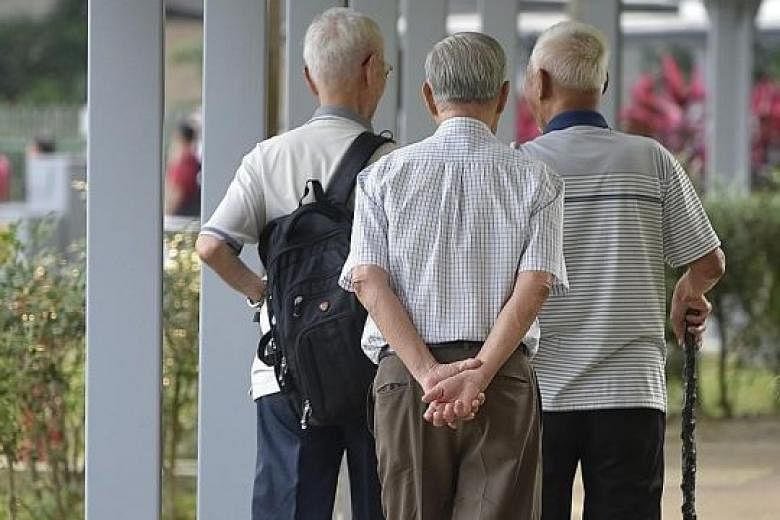In his Budget speech on Feb 19, Finance Minister Heng Swee Keat made a number of references to the needs of the older population.
I commend the plan to consolidate social and health-related services for seniors under the Ministry of Health. There is a clear link between social well-being and physical health.
A few issues from the Budget speech were not so clear-cut and need clarification. In reference to ageing as a challenge, Mr Heng stated: "There will be a significant increase in healthcare and social expenditure, placing greater demands on families and the Government."
It is commonly assumed that healthcare costs are on the rise. The upward trend has been attributed to an ageing population. But Professor Paul McDonald, pro-vice-chancellor at Massey University's College of Health, frames the issue differently: He argues that one of the main causes of the increase in healthcare costs is not an ageing population per se, but an increase in chronic illness.
Singapore has the second-highest rate of diabetes in the world, and also high rates of high blood pressure and high cholesterol levels. Part of the increased healthcare costs should be attributed to the increased prevalence of chronic disease, and we should not let older people carry the blame. The wrong impression creates tension between the generations and also hinders targeted attention at the problem.
A second major cause of high healthcare costs, says Prof McDonald, is end-of-life care. Healthcare costs are highest in the last six months of a person's life, regardless of their age of death. After accounting for the effects of chronic diseases and end-of-life care, ageing is responsible for only a small measure of annual increases in health costs.

A key challenge for Singapore's healthcare sector is therefore to reduce the impact and incidence of chronic illness and to find ways to help people make clear end-of-life plans.
A second issue raised by the Budget that requires further consideration has to do with Mr Heng's statement that "our resident workforce will shrink, tightening our labour... unless we remain dynamic in our outlook, are increasingly productive in the way we work, and supplement our workforce with a calibrated inflow of workers from abroad".
Current re-employment legislation may inadvertently lead to discrimination against older workers. From July 1 last year, employers must offer re-employment to eligible employees who turn 62, up to the age of 67. But even employees lucky enough to get re-employed and continue with the same job often find their wages reduced, and their contracts have to be renewed annually. Often, termination of service can be done at any time without any reason by serving notice as stipulated in the contract.
If the employer thinks that the employee cannot be offered re-employment, then the company can offer a one-off employment assistance of 31/2 months of salary (maximum of $13,000). That age discrimination exists in employment has been revealed in research by the Institute of Policy Studies. The Ministry of Manpower has acknowledged that "specific anti-discrimination laws" may be needed to deal with age discrimination in employment. However, to date, no legislation has been passed to curb this. On the other side of the coin, older people are still expected to be self-reliant through employment. This is what it feels like to be caught between a rock and a hard place.
The median age of Singapore's workforce is 43, and is expected to rise to 47 by 2020. Currently, one in three workers is already 50 years old and over. In the near future, they will constitute the majority of the workforce. This is Singapore's reality. There is no place for age discrimination.
How well we adapt our employment culture and how well we eliminate ageism from our employment practices will determine Singapore's future economic and social viability.
A third issue to consider is the Community Networks for Seniors model. Mr Heng said: "In 2016, I announced the pilot of the Community Networks for Seniors (CNS). CNS brings together government agencies and community partners to do ABC. A is for Active Ageing, to encourage seniors to remain active and stay healthy. B is for Befriending, to link up lonely seniors with new friends. And C is for Care, for frail and vulnerable seniors.
"I believe that the CNS model can meaningfully improve the lives of many other seniors. To reach out to and serve more seniors, we will expand CNS nationwide by 2020."
Before the CNS model becomes nationwide, some questions have to be answered. Has there been an evidence-based study done on the effectiveness of this scheme? Many volunteers are used. How are they selected and are they reimbursed? How are the volunteers trained in this area, including in gerontology? Are we expecting this scheme to be sustained on the goodwill of unpaid good-hearted volunteers? Is this sustainable, and is this likely to meet people's actual needs?
The new norm for Singapore is a society of longer lives. This is an unrecognised valuable resource but is usually dismissed as a dependency issue. Because of the stereotyping of older people as part of the past, they are often overlooked in society's plans for the future. If older Singaporeans are considered as an asset, there will be a different orientation towards health and social expenditure for this increasingly bigger group of citizens.
- The writer is founder president of Wings (a non-profit dedicated to empowering women to age with confidence) and a former nominated Member of Parliament.

